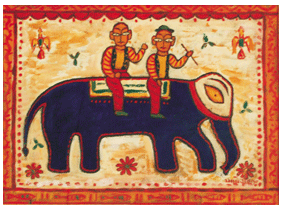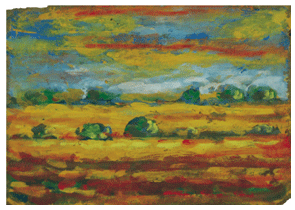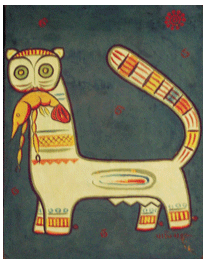- Guest Editor’s Column
- Hard Talk
- All Roads Lead to Delhi's New Art Street
- Art Nouveau : New Art Furniture
- Book Review
- Visualising Sastriya Music :
- Jamini Roy's Conviction & Marketing Strategy
- In the News
- The month that was
- Art's eye-view
- Art Bengaluru
- Photographing Rickshaws through Theatrical Eyes
- The Newspaper, the Text & the Critique
- Artist Index and Statistics
- Market Insight
- Auction Reports : What happened
- Auction Reports : what's forthcoming
- Dakshin Paschim
- Progress of Non-Abstract Geometry
- Indian Life and Landscape by Western Artists
- Recent Works by Prabhavathi Meppayil
- April Salon
- In Transition: New Art from India
- Modern Folk
- Nothing Lost in Transition
- Different hues of Aakriti
- Sotheby’s : Important Watches
ART news & views
Jamini Roy's Conviction & Marketing Strategy
Volume: 2 Issue No: 4 Month: 5 Year: 2010
Essentially a complex artist, Jamini Roy's art historical category defying, deceptively simplistic signature style paintings are resultant outcomes of deep cognition of necessity of art in decolonizing juncture of Indian history.  While a re-valuation of many of the genuine avant-guardes of modern Indian art, including Jamini Roy, without hangover of borrowed preconceived notions, is over due, one aspect of Jamini Roy's art practice, as that of a pioneering modern individual professional artist's, in an art market- less situation, calls for an attention which so far has not been given.
While a re-valuation of many of the genuine avant-guardes of modern Indian art, including Jamini Roy, without hangover of borrowed preconceived notions, is over due, one aspect of Jamini Roy's art practice, as that of a pioneering modern individual professional artist's, in an art market- less situation, calls for an attention which so far has not been given.
Trained in the European academic modalities and notions of art making, Jamini Roy travelled the right royal path to Euro-genetic Modernism's essential aesthetism, including putting a premium on the parallel autonomous world of art with a capital A. However, having been a rural born of an underdeveloped colony, and that too of an era when Gandhiji's and Rabindranath's calls for aligning oneself with ongoing life and nature for decolonisation of mind, Jamini Roy realised the necessity of art in life. He further realised that alienated individual’s alien aesthetism was not for him. These realisations led Jaminibabu, through travails, to his signature style. Even though an aesthete, as a social being of basically a rural society, he knew that art was not just a cathartic outpouring of an individual mind, it had to be socially recognized. In the living tradition of the pata painting of the patuas and folk toys of rural Bengal, Jaminibabu found elements which he could morph to a personal idiom – an idiom which  while satisfying his own aesthetic sensibilities, would, at the same time, be recognised by people as valid art, due to continuity of the visual language.
while satisfying his own aesthetic sensibilities, would, at the same time, be recognised by people as valid art, due to continuity of the visual language.
One thing led to another. To the indigenous modern Jamini Roy, the so-called mystery of the unique work of art, created by a unique genius, at a momentous juncture, was a cleverly designed but basically irrational ploy of the capitalists market forces, to create an aura around a work of art, in order to promote a myth of unique possession – only to price the object d'art irrationally-out of sync with the intrinsic value of the work. The artists of the pre- capitalist societies everywhere, and not only of the rural agrarian and tribal communities, but also of societies with cognition of distinctiveness of art, knew that intrinsic worth of art did not depend upon uniqueness of make and look. Similarities and similarities with variations, in no way made much of a difference in intrinsic value of art. Only when similarities ceased to high- light the variations, and amounted to uninspired repetitions, cloning and production of facsimilies, art become a lost quality.
Taking off from the aforementioned first premise as, as above, Jaminibabu came to the conclusion that executing a work of art from its conception to finish by an artist singly – a prime, consideration for an object of art, was a historically an unsustainable notion, a fetishism cleverly promoted by market forces. In all pre-capitalist societies, including the post-renaissance to the pre-modern Europe, art production used to be group activity.  As long as such a production or creation was conceived and the process was supervised and guided by a master, the created object d'art would unquestionably be the master's. Has not postmodernism gone back to a similar philosophy of art production, inspite of an emphasis on the process of making? Was not Jamini Roy thinking was in advance of his era?
As long as such a production or creation was conceived and the process was supervised and guided by a master, the created object d'art would unquestionably be the master's. Has not postmodernism gone back to a similar philosophy of art production, inspite of an emphasis on the process of making? Was not Jamini Roy thinking was in advance of his era?
Some may contend that Jamini Roy's defence of using stock images and imagery as well as his justification for employing his son, daughter-in-law, grandsons and a few loyal students, especially from the forties of the last century, that is, when his reputation had reached the peak, for producing variations of his work were clever rationalizations for quantitatively enhanced production. This is clearly a cynical view of Jaminibabu's mode of work. Even if that mode is recognized as a strategy of marketing in a non-market situation, it was resultant of a well thought out conviction, as we have seen. A deeply-aligned indigenous modernist and a non-abstract formalist, Jaminibabu with his belief in art-in-life wanted to reach his art to every middle class Bengali home. In order to do so he made it a point to price his work really affordable to the largest group. Even when he was regarded as the foremost painter of the country, in the forties, fifties and sixties of the last century, his work would be available below one third the prices of the other painters whose names would be taken after his. His conviction-borne working strategy had made that possible.